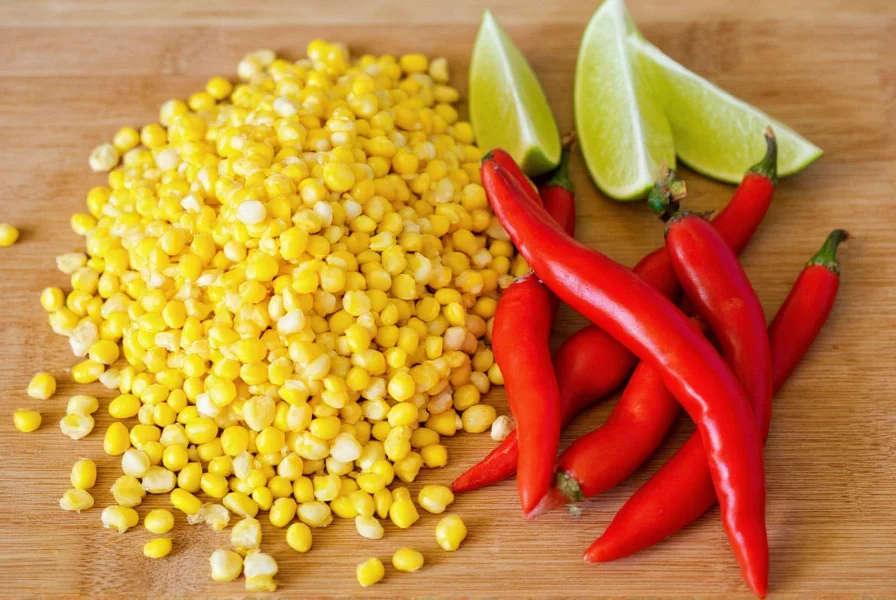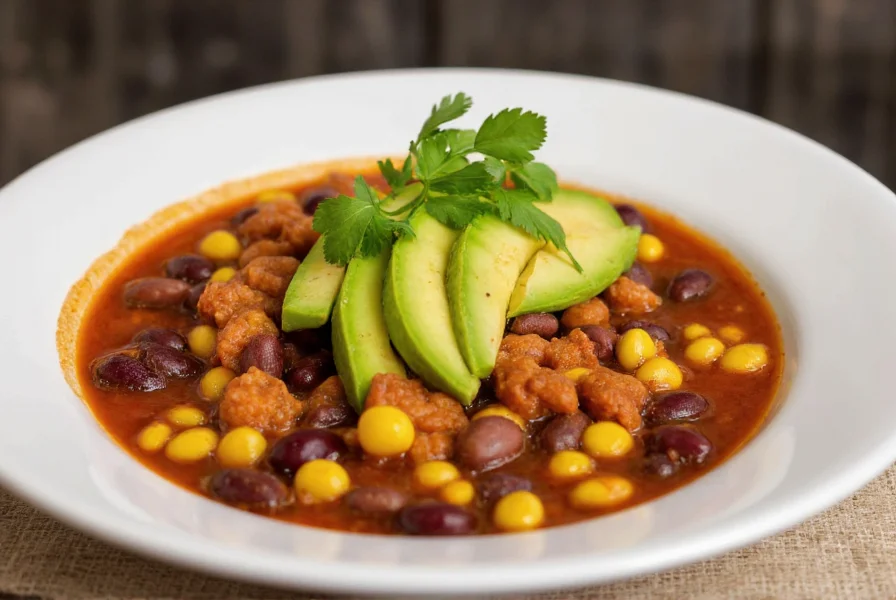When exploring the versatile relationship between corn and chili, you're tapping into a culinary tradition that spans centuries across multiple cultures. This pairing isn't just happenstance—it's a scientifically sound flavor combination where the natural sugars in corn counteract capsaicin's heat while preserving the chili's aromatic complexity. Understanding this interaction opens doors to creating balanced dishes that satisfy multiple taste receptors simultaneously.
The Science Behind Corn and Chili Compatibility
Corn contains natural sugars that activate our sweet taste receptors, while chilies trigger heat receptors through capsaicin compounds. When combined, the sugars in corn help neutralize some of the burning sensation from capsaicin without eliminating the chili's flavor complexity. This biochemical interaction creates what food scientists call "flavor layering"—where multiple taste sensations work together rather than competing.
Interestingly, the starch content in corn also plays a role. When heated, corn's starches release compounds that enhance our perception of umami, creating a third dimension to the flavor profile that complements both sweet and spicy elements. This is why corn and chili combinations often feel more "complete" than using either ingredient alone.
Traditional Dishes Featuring Corn and Chili
Cultures worldwide have perfected corn and chili combinations through generations of culinary experimentation. In Mexico, esquites (Mexican street corn salad) combines boiled corn kernels with chili powder, lime, and cotija cheese. Peruvian choclo con queso features large-kernel corn served with spicy chili sauces. Across the American South, cornbread often incorporates jalapeños for a sweet-heat balance.
| Dish | Region | Key Ingredients | Chili Type Used |
|---|---|---|---|
| Esquites | Mexico | Corn, lime, cheese, chili | Jalapeño or chili powder |
| Chili con Corn | Southwestern US | Corn, beans, meat, tomatoes | Ancho or chipotle |
| Sopa de Elote | Central America | Creamy corn soup | Guajillo or pasilla |
| Corn and Chili Relish | Caribbean | Corn, vinegar, spices | Habanero or scotch bonnet |
Perfect Pairing Techniques for Home Cooking
When working with corn and chili in your kitchen, timing and preparation methods significantly impact the final flavor profile. For fresh corn applications like salsas, add finely diced chili after cooking the corn to preserve its bright, fresh heat. In soups and stews, sautéing the chili first with aromatics builds a flavor foundation that the corn then complements.
Consider these professional techniques for optimal corn and chili recipes:
- Temperature control: Add corn toward the end of cooking when using fresh kernels to maintain sweetness and texture
- Seed management: Remove chili seeds and membranes for milder heat while retaining flavor
- Acid balance: A splash of lime juice after cooking enhances both corn's sweetness and chili's complexity
- Texture contrast: Combine whole corn kernels with finely minced chili for varied mouthfeel

Seasonal Considerations for Corn and Chili Dishes
The quality of your corn and chili pairing depends heavily on ingredient seasonality. Fresh sweet corn peaks in summer months (June-August in North America), while many chili varieties are harvested from late summer through fall. During corn's peak season, fresh kernels provide superior sweetness that balances chili heat perfectly.
When fresh corn isn't available, frozen corn often preserves sweetness better than canned varieties. For chilies, consider these seasonal substitutions:
- Summer: Fresh jalapeños, serranos, or poblanos
- Fall/Winter: Dried ancho, guajillo, or chipotle peppers
- Year-round: High-quality canned green chilies
Understanding these seasonal variations helps maintain consistent results in your corn and chili recipes throughout the year, whether you're making simple weeknight dinners or special occasion dishes.

Advanced Corn and Chili Recipe Ideas
For those ready to elevate their corn and chili creations, consider these sophisticated applications that showcase this classic pairing:
Corn and Roasted Poblano Chowder
This creamy soup balances sweet corn with the earthy heat of roasted poblano peppers. The key technique involves charring the poblanos directly over gas flame until blackened, then steaming them in a covered bowl to loosen skins. After removing skins and seeds, blend the roasted peppers with sautéed onions, garlic, and vegetable broth before adding fresh corn kernels during the final simmer.
Grilled Corn with Chili-Lime Butter
An upgraded version of Mexican street corn, this recipe incorporates finely minced serrano pepper into softened butter along with lime zest and juice. After grilling corn until slightly charred, roll each ear in the chili-lime butter, then sprinkle with crumbled queso fresco and smoked paprika for additional flavor dimensions.
Chili-Corn Relish for Proteins
This versatile condiment combines fresh corn kernels with finely diced jalapeño, red onion, cilantro, and a vinegar-based dressing. The acidity preserves the corn's sweetness while allowing the chili's heat to mellow slightly. Perfect for topping grilled chicken, fish, or tofu, this relish demonstrates how corn and chili can enhance proteins without overwhelming them.
Storage and Preservation Techniques
Preserving the quality of both corn and chili extends your ability to create balanced dishes year-round. For fresh corn, remove husks and store kernels in airtight containers with a damp paper towel for up to 3 days in the refrigerator. Blanching corn before freezing preserves sweetness better than freezing raw.
Chilies can be preserved through multiple methods:
- Freezing: Whole or sliced chilies freeze well for 6-8 months
- Drying: Creates concentrated flavor ideal for soups and stews
- Pickling: Preserves fresh heat while adding acidity that complements corn
- Roasting and freezing: Preserves complex roasted flavors for future use
When preserving both ingredients together, consider making small-batch corn and chili salsas or relishes that can be frozen in ice cube trays then transferred to freezer bags. This method provides ready-to-use flavor combinations for quick meal enhancement.
Frequently Asked Questions
What type of chili works best with sweet corn in summer dishes?
Jalapeños provide the ideal balance for summer corn dishes, offering moderate heat that complements rather than overwhelms corn's natural sweetness. For milder flavor, remove seeds and membranes; for more heat, include some seeds. Serranos work well for those preferring more intense heat while maintaining flavor complexity.
How can I reduce the heat of chili in corn dishes without losing flavor?
To reduce chili heat while preserving flavor, remove seeds and white membranes (where most capsaicin resides), then soak diced chilies in lime juice for 10-15 minutes before adding to corn dishes. The acid helps neutralize some heat compounds while enhancing overall flavor. Alternatively, roast chilies first to mellow their heat while developing complex roasted flavors that complement corn.
Can I use canned corn with fresh chili in recipes?
Yes, canned corn works well with fresh chili, though it requires technique adjustments. Drain and rinse canned corn thoroughly to remove metallic taste, then sauté briefly in butter to restore some sweetness before adding fresh chili. For best results, use canned corn in cooked applications like soups and chilis rather than fresh preparations like salsas where texture matters more.
What's the science behind corn reducing chili heat?
Corn reduces chili heat through two mechanisms: its natural sugars bind with capsaicin molecules (the compounds that create heat), making them less available to trigger heat receptors, and its starch content creates a physical barrier that slows capsaicin absorption. This biochemical interaction allows the aromatic compounds in chili to remain perceptible while reducing the burning sensation, creating a more balanced flavor experience.
How do I store leftover corn and chili dishes properly?
Store corn and chili leftovers in airtight containers in the refrigerator for up to 3-4 days. The acidity from tomatoes or lime juice in many corn and chili dishes helps preservation, but always cool dishes completely before refrigerating. For longer storage, freeze portions in freezer-safe containers for up to 3 months. When reheating, add a splash of water or broth to restore moisture, as corn tends to absorb liquid during storage.











 浙公网安备
33010002000092号
浙公网安备
33010002000092号 浙B2-20120091-4
浙B2-20120091-4